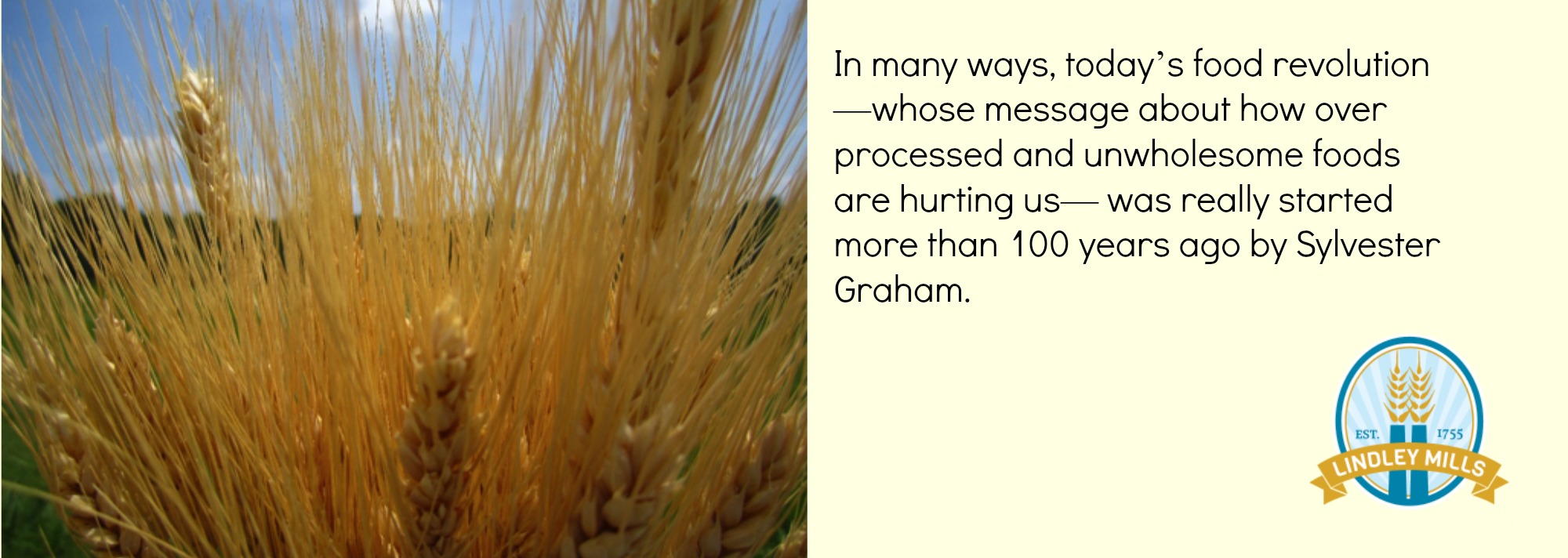
Almost every American, young or old, has heard of Graham crackers. Many associate this staple food with warm memories of making s’mores around a campfire, or at home watching the marshmallow puff, brown, and melt through the window of a microwave oven. Yet, few Americans have ever heard of Graham flour or its inventor and namesake, Sylvester Graham (1794-1851).
Rev. Graham was a 19th century Presbyterian minister and an early advocate for dietary reform who created what would later become known as the “Graham System of Living.” Inspired by the temperance movement, Graham was also an advocate for vegetarianism and believed that the poor health of his fellow Americans could be attributed to changes in diet brought on by the Industrial Revolution, particularly the commoditization of flour and bread.
A Revolutionary Idea: Whole Wheat Bread for Good Health
To combat the poor diets of Americans in 1829, Graham began making bread (and later crackers) out of whole wheat flour. At that time, consumer perception was that whole wheat bread was food for the lower class and white bread was more sophisticated. However, Graham condemned the widespread use of commercial additives (such as alum and chlorine) used to make breads whiter and finer. He argued that these chemicals in the more ‘sophisticated’ white bread made it unwholesome, and published his views in, A Treatise on Bread and Breadmaking, in 1837.
Graham strongly believed that bread should be homemade, whole grain, and coarsely ground. He rallied for his cause by giving lectures and publishing articles on the Graham System for Living. Like every revolutionary thinker, he met resistance in his own time, but was generations ahead of society. The Graham System eschewed overly processed food, and advocated moderation in all areas of daily life, a familiar refrain for those “plugged-in” to discussions on food today. In many ways, today’s food revolution—which is inspired by contemporaries like Michael Pollan—whose message about how over processed and unwholesome foods are hurting us, was really started more than 100 years ago by Sylvester Graham.
A Tarnished Legacy
While Graham’s lasting legacy can be found on any grocery store shelf, it too has become an over processed icon, a far cry from Graham’s vision of whole grain, coarsely ground bread and crackers. Looking across the grocery store shelves, we find ingredients we can’t pronounce or easily understand. As the organic and local movements have grown, and more people are eating what their local farmers and millers produce, the push for organic products has certainly gotten more attention, and the seeds are being sown for another food revolution with the aim of increasing the whole grains in our diets. At Lindley Mills, we believe the most versatile and nutritious way to do this is with Super Sprout™.
The New Revolution: Whole Grains for Good Health
Super Sprout™ Sprouted Whole Grain Wheat Flour would have been Sylvester Graham’s dream come to life. It is a whole grain, whole wheat flour made with a process that allows your body to recognize it as a vegetable for maximum nutrient-absorption and easy digestion. Not only are products made with this flour more nutritious, they taste better because the natural sugars have been enhanced by the sprouting process. Sprouted whole grain flour goes a step beyond Graham’s vision of eating whole grain flour and takes advantage of the whole live wheat grain and all of its nutrition, instead of just the dormant seed.
Revolutionize your baking and try Super Sprout™ Sprouted Whole Grain Wheat Flour for a healthy flavor boost. Read what other bakers have said about using Super Sprout™ in their products here, and let us know your favorite way to eat whole grains!
Sources:
1. Graham, Sylvester. A Treatise on Bread and Breadmaking. Boston: Light & Stearns, 1837. Full publication available online here.
2. Graham, Sylvester. A Defence of the Graham System of Living, or, Remarks on diet and regimen: Dedicated to the Rising Generation. W. Applegate, 1835. Available online here.
3. Balmer, Randall. The Encyclopedia of Evangelicalism. “Graham, Sylvester.” Baylor University Press, 2002. Available online here.
4. “How Graham Bread Came to be Made,” San Francisco Call, Volume 103, Number 101, March, 10, 1908. Available online here.
5. Bates, Christopher. The Early Republic and Antebellum America: An Encyclopedia of Social, Political, Cultural, and Economic History. “Graham, Sylvester.” Routledge, 2015. Available online here.



